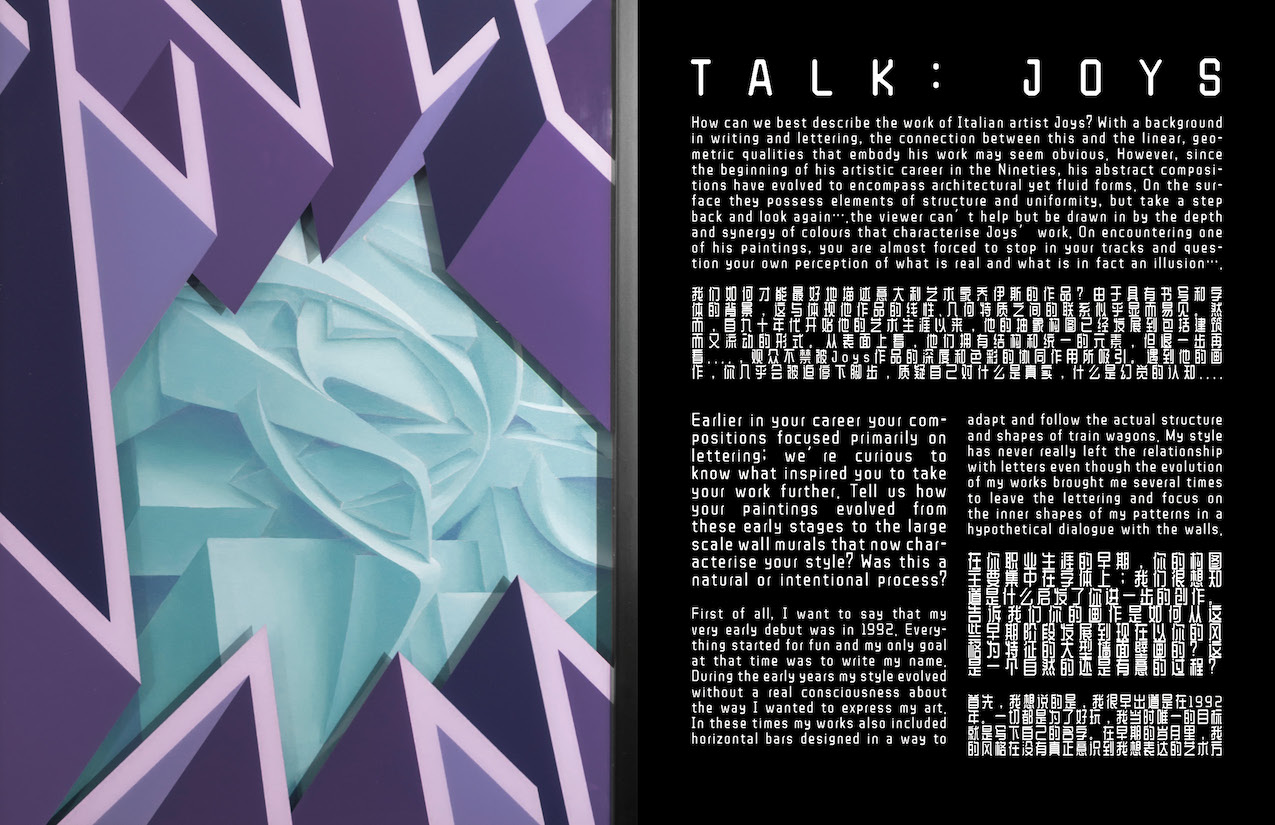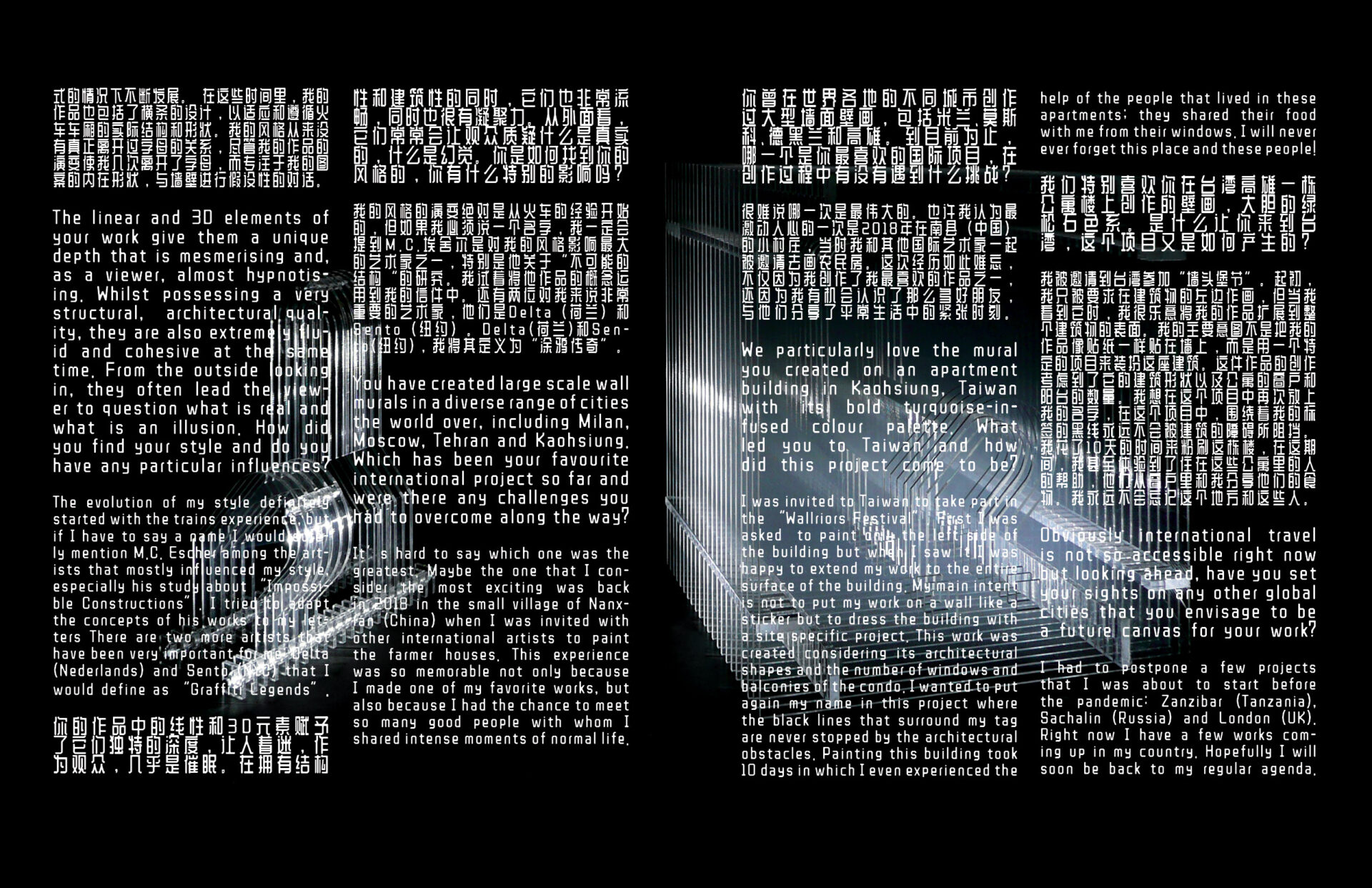
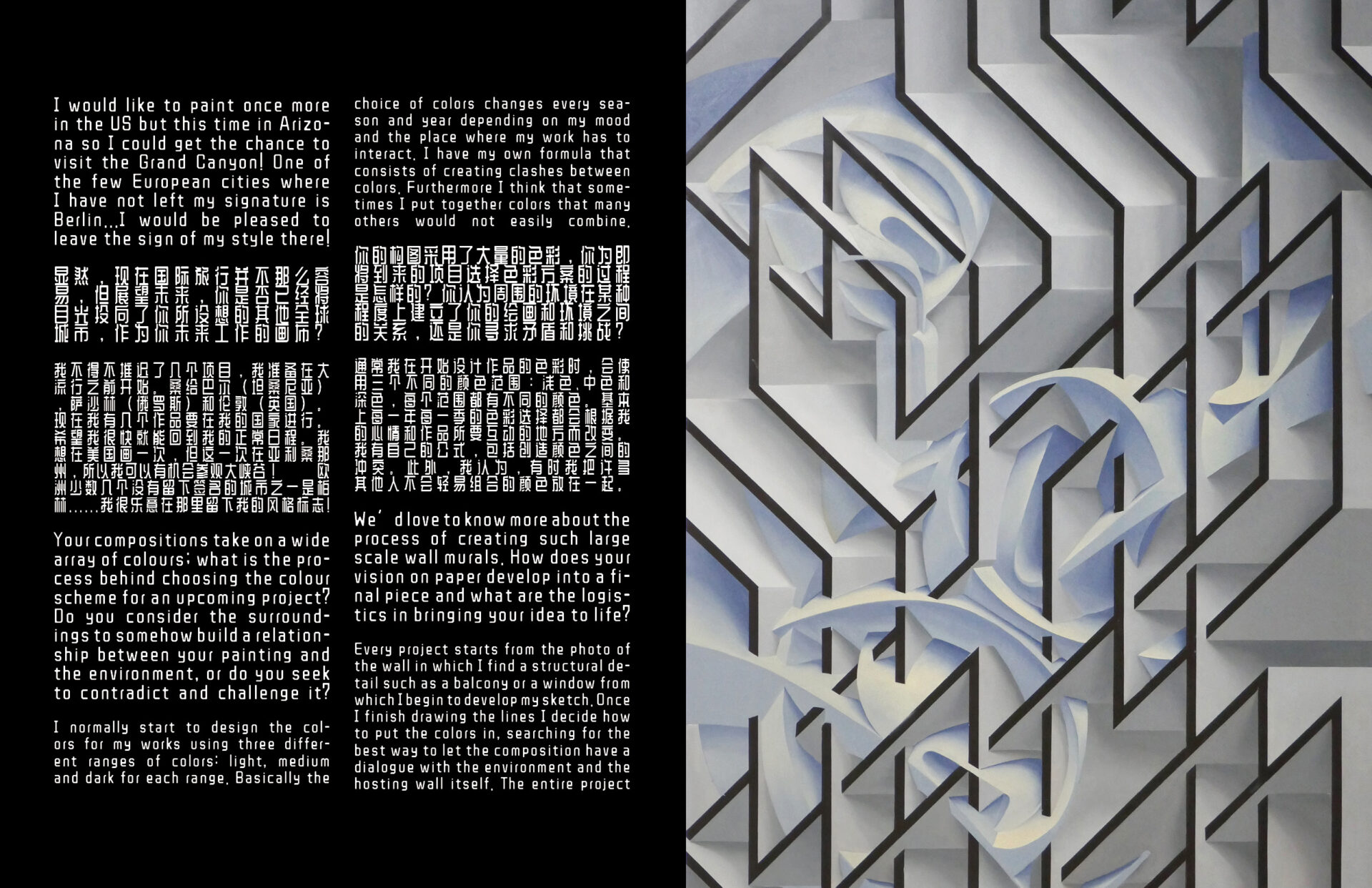
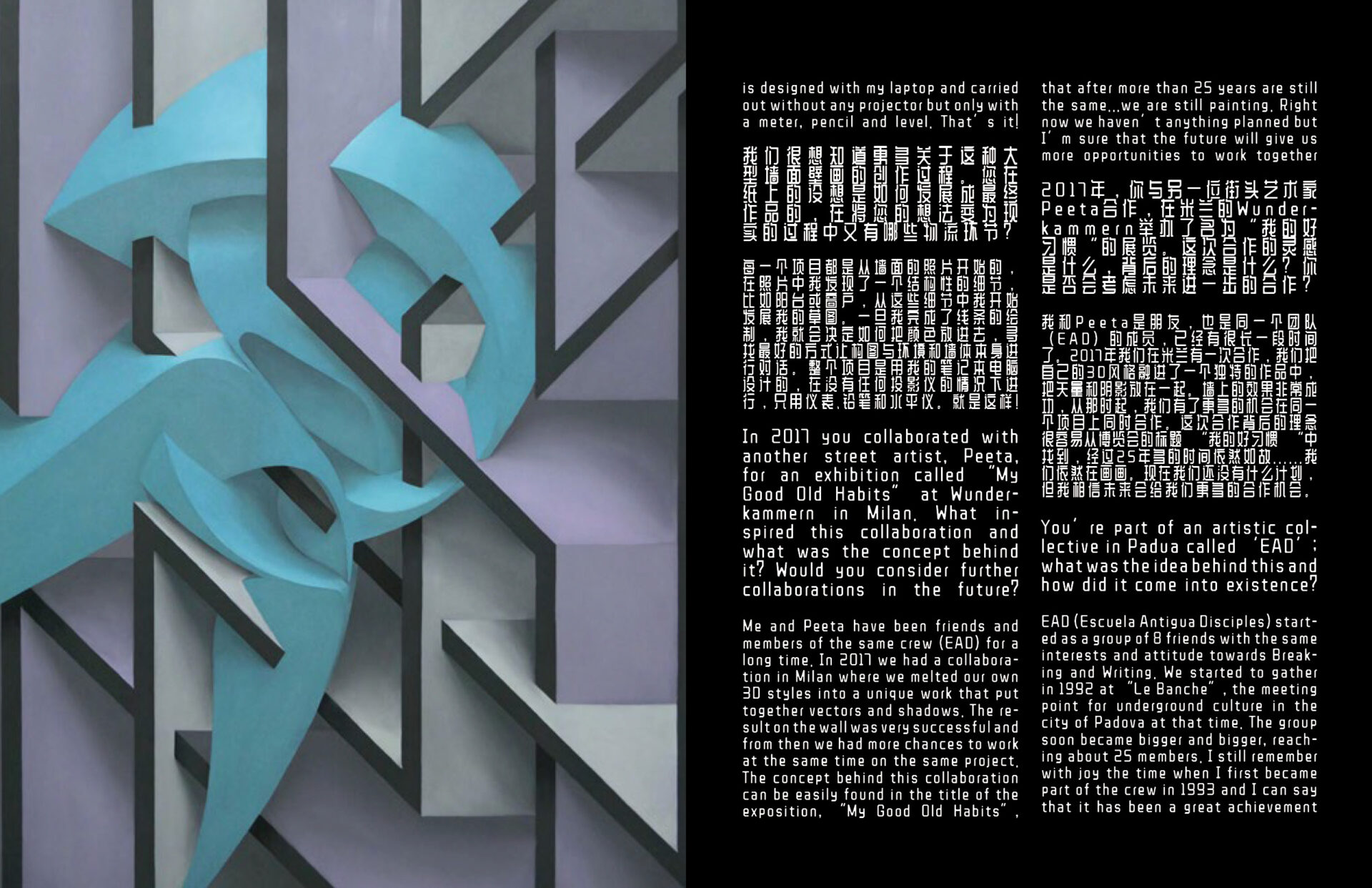
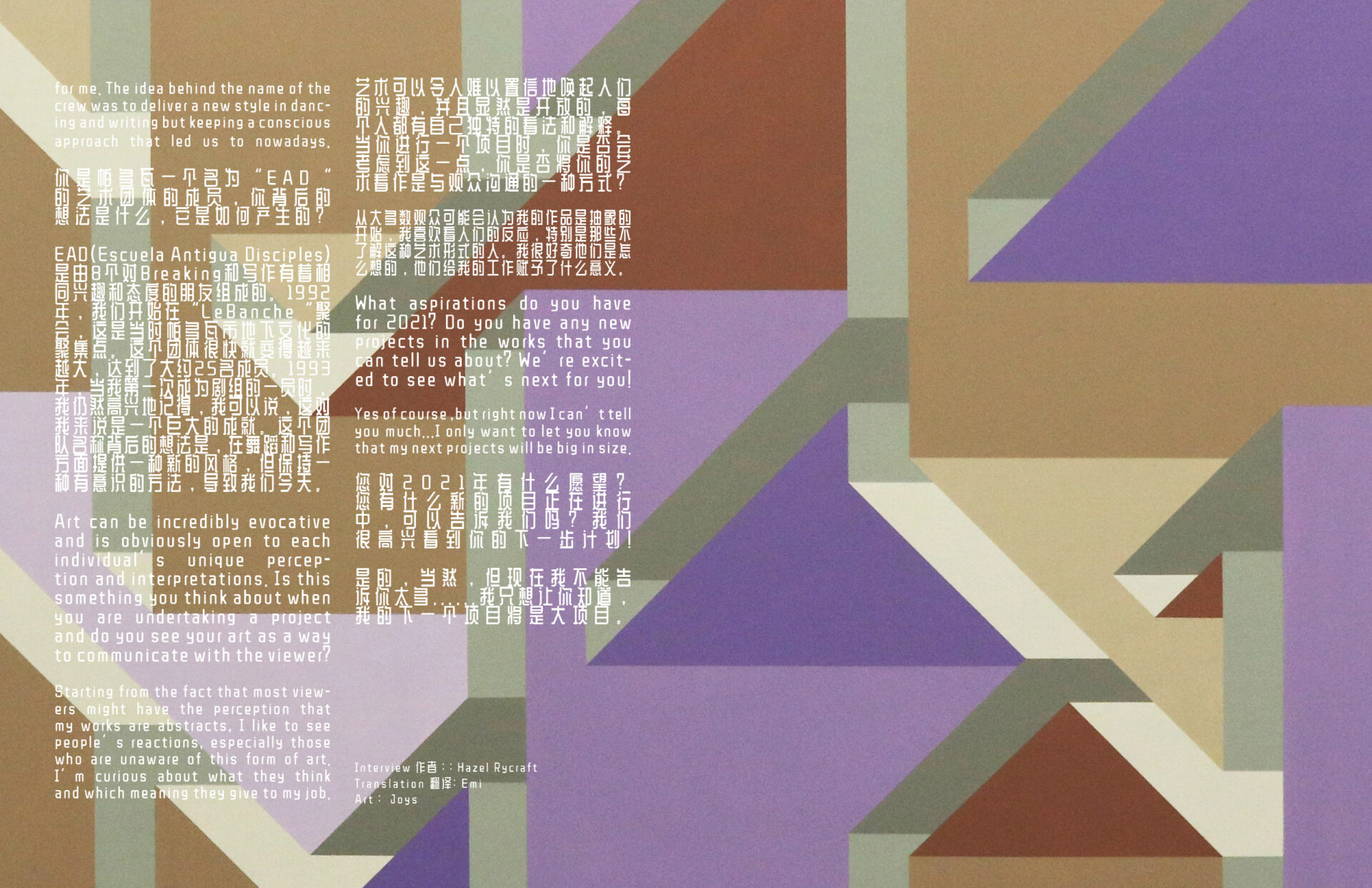
How can we best describe the work of Italian artist Joys? With a background in writing and lettering, the connection between this and the linear, geometric qualities that embody his work may seem obvious. However, since the beginning of his artistic career in the Nineties, his abstract compositions have evolved to encompass architectural yet fluid forms. On the surface they possess elements of structure and uniformity, but take a step back and look again….the viewer can’t help but be drawn in by the depth and synergy of colours that characterise Joys’ work. On encountering one of his paintings, you are almost forced to stop in your tracks and question your own perception of what is real and what is in fact an illusion….
我们如何才能最好地描述意大利艺术家乔伊斯的作品?由于具有书写和字体的背景,这与体现他作品的线性、几何特质之间的联系似乎显而易见。然而,自九十年代开始他的艺术生涯以来,他的抽象构图已经发展到包括建筑而又流动的形式。从表面上看,他们拥有结构和统一的元素,但退一步再看….,观众不禁被Joys作品的深度和色彩的协同作用所吸引。遇到他的画作,你几乎会被迫停下脚步,质疑自己对什么是真实,什么是幻觉的认知….
Earlier in your career your compositions focused primarily on lettering; we’re curious to know what inspired you to take your work further. Tell us how your paintings evolved from these early stages to the large scale wall murals that now characterise your style? Was this a natural or intentional process?
First of all, I want to say that my very early debut was in 1992. Everything started for fun and my only goal at that time was to write my name. During the early years my style evolved without a real consciousness about the way I wanted to express my art. In these times my works also included horizontal bars designed in a way to adapt and follow the actual structure and shapes of train wagons. My style has never really left the relationship with letters even though the evolution of my works brought me several times to leave the lettering and focus on the inner shapes of my patterns in a hypothetical dialogue with the walls.
在你职业生涯的早期,你的构图主要集中在字体上;我们很想知道是什么启发了你进一步的创作。告诉我们你的画作是如何从这些早期阶段发展到现在以你的风格为特征的大型墙面壁画的?这是一个自然的还是有意的过程?
首先,我想说的是,我很早出道是在1992年。一切都是为了好玩,我当时唯一的目标就是写下自己的名字。在早期的岁月里,我的风格在没有真正意识到我想表达的艺术方式的情况下不断发展。 在这些时间里,我的作品也包括了横条的设计,以适应和遵循火车车厢的实际结构和形状。我的风格从来没有真正离开过字母的关系,尽管我的作品的演变使我几次离开了字母,而专注于我的图案的内在形状,与墙壁进行假设性的对话。
The linear and 3D elements of your work give them a unique depth that is mesmerising and, as a viewer, almost hypnotising. Whilst possessing a very structural, architectural quality, they are also extremely fluid and cohesive at the same time. From the outside looking in, they often lead the viewer to question what is real and what is an illusion. How did you find your style and do you have any particular influences?
The evolution of my style definitely started with the trains experience, but if I have to say a name I would surely mention M.C. Escher among the artists that mostly influenced my style, especially his study about “Impossible Constructions”. I tried to adapt the concepts of his works to my letters There are two more artists that have been very important for me: Delta (Nederlands) and Sento (NYC) that I would define as “Graffiti Legends”.
你的作品中的线性和3D元素赋予了它们独特的深度,让人着迷,作为观众,几乎是催眠。在拥有结构性和建筑性的同时,它们也非常流畅,同时也很有凝聚力。从外面看,它们常常会让观众质疑什么是真实的,什么是幻觉。你是如何找到你的风格的,你有什么特别的影响吗?
我的风格的演变绝对是从火车的经验开始的,但如果我必须说一个名字,我一定会提到M.C.埃舍尔是对我的风格影响最大的艺术家之一,特别是他关于“不可能的结构“的研究。我试着将他作品的概念运用到我的信件中。还有两位对我来说非常重要的艺术家,他们是Delta(荷兰)和Sento(纽约)。Delta(荷兰)和Sento(纽约),我将其定义为“涂鸦传奇”。
You have created large scale wall murals in a diverse range of cities the world over, including Milan, Moscow, Tehran and Kaohsiung. Which has been your favourite international project so far and were there any challenges you had to overcome along the way?
It’s hard to say which one was the greatest. Maybe the one that I consider the most exciting was back in 2018 in the small village of Nanxian (China) when I was invited with other international artists to paint the farmer houses. This experience was so memorable not only because I made one of my favorite works, but also because I had the chance to meet so many good people with whom I shared intense moments of normal life.
你曾在世界各地的不同城市创作过大型墙面壁画,包括米兰、莫斯科、德黑兰和高雄。到目前为止,哪一个是你最喜欢的国际项目,在创作过程中有没有遇到什么挑战?
很难说哪一次是最伟大的。也许我认为最激动人心的一次是2018年在南县(中国)的小村庄,当时我和其他国际艺术家一起被邀请去画农民房。这次经历如此难忘,不仅因为我创作了我最喜欢的作品之一,还因为我有机会认识了那么多好朋友,与他们分享了平常生活中的紧张时刻。
We particularly love the mural you created on an apartment building in Kaohsiung, Taiwan with its bold turquoise-infused colour palette. What led you to Taiwan and how did this project come to be?
I was invited to Taiwan to take part in the “Wallriors Festival”. First I was asked to paint only the left side of the building but when I saw it I was happy to extend my work to the entire surface of the building. My main intent is not to put my work on a wall like a sticker but to dress the building with a site specific project. This work was created considering its architectural shapes and the number of windows and balconies of the condo. I wanted to put again my name in this project where the black lines that surround my tag are never stopped by the architectural obstacles. Painting this building took 10 days in which I even experienced the help of the people that lived in these apartments; they shared their food with me from their windows. I will never ever forget this place and these people!
我们特别喜欢你在台湾高雄一栋公寓楼上创作的壁画,大胆的绿松石色系。是什么让你来到台湾,这个项目又是如何产生的?
我被邀请到台湾参加“墙头堡节”。起初,我只被要求在建筑物的左边作画,但当我看到它时,我很乐意将我的作品扩展到整个建筑物的表面。我的主要意图不是把我的作品像贴纸一样贴在墙上,而是用一个特定的项目来装扮这座建筑。这件作品的创作考虑到了它的建筑形状以及公寓的窗户和阳台的数量。我想在这个项目中再次放上我的名字,在这个项目中,围绕着我的标签的黑线永远不会被建筑的障碍所阻挡。我花了10天的时间来粉刷这栋楼,在这期间,我甚至体验到了住在这些公寓里的人的帮助,他们从窗户里和我分享他们的食物。我永远不会忘记这个地方和这些人。
Obviously international travel is not so accessible right now but looking ahead, have you set your sights on any other global cities that you envisage to be a future canvas for your work?
I had to postpone a few projects that I was about to start before the pandemic: Zanzibar (Tanzania), Sachalin (Russia) and London (UK). Right now I have a few works coming up in my country. Hopefully I will soon be back to my regular agenda.
I would like to paint once more in the US but this time in Arizona so I could get the chance to visit the Grand Canyon! One of the few European cities where I have not left my signature is Berlin…I would be pleased to leave the sign of my style there!
显然,现在国际旅行并不那么容易,但展望未来,你是否已经将目光投向了你所设想的其他全球城市,作为你未来工作的画布?
我不得不推迟了几个项目,我准备在大流行之前开始。桑给巴尔(坦桑尼亚),萨沙林(俄罗斯)和伦敦(英国)。现在我有几个作品要在我的国家进行。希望我很快就能回到我的正常日程。我想在美国画一次,但这一次在亚利桑那州,所以我可以有机会参观大峡谷! 欧洲少数几个没有留下签名的城市之一是柏林……我很乐意在那里留下我的风格标志!
Your compositions take on a wide array of colours; what is the process behind choosing the colour scheme for an upcoming project? Do you consider the surroundings to somehow build a relationship between your painting and the environment, or do you seek to contradict and challenge it?
I normally start to design the colors for my works using three different ranges of colors: light, medium and dark for each range. Basically the choice of colors changes every season and year depending on my mood and the place where my work has to interact. I have my own formula that consists of creating clashes between colors. Furthermore I think that sometimes I put together colors that many others would not easily combine.
你的构图采用了大量的色彩,你为即将到来的项目选择色彩方案的过程是怎样的?你认为周围的环境在某种程度上建立了你的绘画和环境之间的关系,还是你寻求矛盾和挑战?
通常我在开始设计作品的色彩时,会使用三个不同的颜色范围:浅色、中色和深色,每个范围都有不同的颜色。基本上每一年每一季的色彩选择都会根据我的心情和作品所要互动的地方而改变。我有自己的公式,包括创造颜色之间的冲突。此外,我认为,有时我把许多其他人不会轻易组合的颜色放在一起。
We’d love to know more about the process of creating such large scale wall murals. How does your vision on paper develop into a final piece and what are the logistics in bringing your idea to life?
Every project starts from the photo of the wall in which I find a structural detail such as a balcony or a window from which I begin to develop my sketch. Once I finish drawing the lines I decide how to put the colors in, searching for the best way to let the composition have a dialogue with the environment and the hosting wall itself. The entire project is designed with my laptop and carried out without any projector but only with a meter, pencil and level. That’s it!
我们很想知道更多关于这种大型墙面壁画的创作过程。您在纸上的设想是如何发展成最终作品的,在将您的想法变为现实的过程中又有哪些物流环节?
每一个项目都是从墙面的照片开始的,在照片中我发现了一个结构性的细节,比如阳台或窗户,从这些细节中我开始发展我的草图。一旦我完成了线条的绘制,我就会决定如何把颜色放进去,寻找最好的方式让构图与环境和墙体本身进行对话。整个项目是用我的笔记本电脑设计的,在没有任何投影仪的情况下进行,只用仪表、铅笔和水平仪。就是这样!
In 2017 you collaborated with another street artist, Peeta, for an exhibition called “My Good Old Habits” at Wunderkammern in Milan. What inspired this collaboration and what was the concept behind it? Would you consider further collaborations in the future?
Me and Peeta have been friends and members of the same crew (EAD) for a long time. In 2017 we had a collaboration in Milan where we melted our own 3D styles into a unique work that put together vectors and shadows. The result on the wall was very successful and from then we had more chances to work at the same time on the same project. The concept behind this collaboration can be easily found in the title of the exposition, “My Good Old Habits”, that after more than 25 years are still the same…we are still painting. Right now we haven’t anything planned but I’m sure that the future will give us more opportunities to work together
2017年,你与另一位街头艺术家Peeta合作,在米兰的Wunderkammern举办了名为“我的好习惯“的展览。这次合作的灵感是什么,背后的理念是什么?你是否会考虑未来进一步的合作?
我和Peeta是朋友,也是同一个团队(EAD)的成员,已经有很长一段时间了。2017年我们在米兰有一次合作,我们把自己的3D风格融进了一个独特的作品中,把矢量和阴影放在一起。墙上的效果非常成功,从那时起,我们有了更多的机会在同一个项目上同时合作。这次合作背后的理念很容易从博览会的标题 “我的好习惯 “中找到,经过25年多的时间依然如故……我们依然在画画。现在我们还没有什么计划,但我相信未来会给我们更多的合作机会。
You’re part of an artistic collective in Padua called ‘EAD’; what was the idea behind this and how did it come into existence?
EAD (Escuela Antigua Disciples) started as a group of 8 friends with the same interests and attitude towards Breaking and Writing. We started to gather in 1992 at “Le Banche”, the meeting point for underground culture in the city of Padova at that time. The group soon became bigger and bigger, reaching about 25 members. I still remember with joy the time when I first became part of the crew in 1993 and I can say that it has been a great achievement for me. The idea behind the name of the crew was to deliver a new style in dancing and writing but keeping a conscious approach that led us to nowadays.
你是帕多瓦一个名为“EAD“的艺术团体的成员,你背后的想法是什么,它是如何产生的?
EAD(Escuela Antigua Disciples)是由8个对Breaking和写作有着相同兴趣和态度的朋友组成的。1992年,我们开始在“LeBanche“聚会,这是当时帕多瓦市地下文化的聚集点。这个团体很快就变得越来越大,达到了大约25名成员。1993年,当我第一次成为剧组的一员时,我仍然高兴地记得,我可以说,这对我来说是一个巨大的成就。这个团队名称背后的想法是,在舞蹈和写作方面提供一种新的风格,但保持一种有意识的方法,导致我们今天。
Art can be incredibly evocative and is obviously open to each individual’s unique perception and interpretations. Is this something you think about when you are undertaking a project and do you see your art as a way to communicate with the viewer?
Starting from the fact that most viewers might have the perception that my works are abstracts, I like to see people’s reactions, especially those who are unaware of this form of art. I’m curious about what they think and which meaning they give to my job.
艺术可以令人难以置信地唤起人们的兴趣,并且显然是开放的,每个人都有自己独特的看法和解释。当你进行一个项目时,你是否会考虑到这一点,你是否将你的艺术看作是与观众沟通的一种方式?
从大多数观众可能会认为我的作品是抽象的开始,我喜欢看人们的反应,特别是那些不了解这种艺术形式的人。我很好奇他们是怎么想的,他们给我的工作赋予了什么意义。
What aspirations do you have for 2021? Do you have any new projects in the works that you can tell us about? We’re excited to see what’s next for you!
Yes of course ,but right now I can’t tell you much…I only want to let you know that my next projects will be big in size.
您对2021年有什么愿望?您有什么新的项目正在进行中,可以告诉我们吗?我们很高兴看到你的下一步计划!
是的,当然,但现在我不能告诉你太多……我只想让你知道,我的下一个项目将是大项目。
Interview 作者:: Hazel Rycraft
Translation 翻译: Emi
Art: Joys



